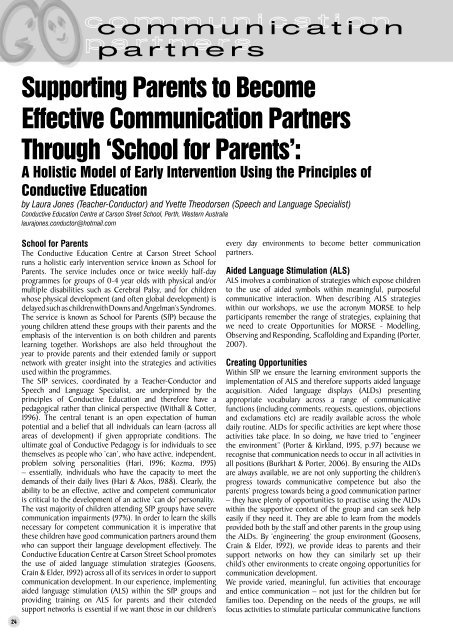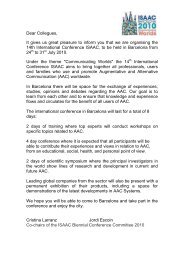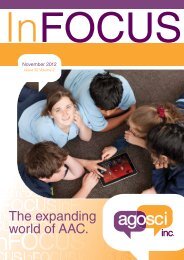May 2008 Edition - agosci
May 2008 Edition - agosci
May 2008 Edition - agosci
You also want an ePaper? Increase the reach of your titles
YUMPU automatically turns print PDFs into web optimized ePapers that Google loves.
ccommunicationo m m u n i c a t i o nppartnersa r t n e r sSupporting Parents to BecomeEffective Communication PartnersThrough ‘School for Parents’:A Holistic Model of Early Intervention Using the Principles ofConductive Educationby Laura Jones (Teacher-Conductor) and Yvette Theodorsen (Speech and Language Specialist)Conductive Education Centre at Carson Street School, Perth, Western Australialaurajones.conductor@hotmail.com24School for ParentsThe Conductive Education Centre at Carson Street Schoolruns a holistic early intervention service known as School forParents. The service includes once or twice weekly half-dayprogrammes for groups of 0-4 year olds with physical and/ormultiple disabilities such as Cerebral Palsy, and for childrenwhose physical development (and often global development) isdelayed such as children with Downs and Angelman’s Syndromes.The service is known as School for Parents (SfP) because theyoung children attend these groups with their parents and theemphasis of the intervention is on both children and parentslearning together. Workshops are also held throughout theyear to provide parents and their extended family or supportnetwork with greater insight into the strategies and activitiesused within the programmes.The SfP services, coordinated by a Teacher-Conductor andSpeech and Language Specialist, are underpinned by theprinciples of Conductive Education and therefore have apedagogical rather than clinical perspective (Withall & Cotter,1996). The central tenant is an open expectation of humanpotential and a belief that all individuals can learn (across allareas of development) if given appropriate conditions. Theultimate goal of Conductive Pedagogy is for individuals to seethemselves as people who ‘can’, who have active, independent,problem solving personalities (Hari, 1996; Kozma, 1995)– essentially, individuals who have the capacity to meet thedemands of their daily lives (Hari & Akos, 1988). Clearly, theability to be an effective, active and competent communicatoris critical to the development of an active ‘can do’ personality.The vast majority of children attending SfP groups have severecommunication impairments (97%). In order to learn the skillsnecessary for competent communication it is imperative thatthese children have good communication partners around themwho can support their language development effectively. TheConductive Education Centre at Carson Street School promotesthe use of aided language stimulation strategies (Goosens,Crain & Elder, 1992) across all of its services in order to supportcommunication development. In our experience, implementingaided language stimulation (ALS) within the SfP groups andproviding training on ALS for parents and their extendedsupport networks is essential if we want those in our children’severy day environments to become better communicationpartners.Aided Language Stimulation (ALS)ALS involves a combination of strategies which expose childrento the use of aided symbols within meaningful, purposefulcommunicative interaction. When describing ALS strategieswithin our workshops, we use the acronym MORSE to helpparticipants remember the range of strategies, explaining thatwe need to create Opportunities for MORSE - Modelling,Observing and Responding, Scaffolding and Expanding (Porter,2007).Creating OpportunitiesWithin SfP we ensure the learning environment supports theimplementation of ALS and therefore supports aided languageacquisition. Aided language displays (ALDs) presentingappropriate vocabulary across a range of communicativefunctions (including comments, requests, questions, objectionsand exclamations etc) are readily available across the wholedaily routine. ALDs for specific activities are kept where thoseactivities take place. In so doing, we have tried to “engineerthe environment” (Porter & Kirkland, 1995, p.97) because werecognise that communication needs to occur in all activities inall positions (Burkhart & Porter, 2006). By ensuring the ALDsare always available, we are not only supporting the children’sprogress towards communicative competence but also theparents’ progress towards being a good communication partner– they have plenty of opportunities to practise using the ALDswithin the supportive context of the group and can seek helpeasily if they need it. They are able to learn from the modelsprovided both by the staff and other parents in the group usingthe ALDs. By ‘engineering’ the group environment (Goosens,Crain & Elder, 1992), we provide ideas to parents and theirsupport networks on how they can similarly set up theirchild’s other environments to create ongoing opportunities forcommunication development.We provide varied, meaningful, fun activities that encourageand entice communication – not just for the children but forfamilies too. Depending on the needs of the groups, we willfocus activities to stimulate particular communicative functions





